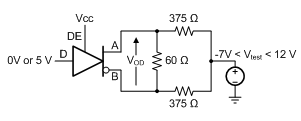SLLSEH3C July 2013 – January 2018 SN65HVD888
PRODUCTION DATA.
- 1 Features
- 2 Applications
- 3 Description
- 4 Revision History
- 5 Pin Configuration and Functions
- 6 Specifications
- 7 Parameter Measurement information
- 8 Detailed Description
- 9 Application and Implementation
- 10Power Supply Recommendations
- 11Layout
- 12Device and Documentation Support
- 13Mechanical, Packaging, and Orderable Information
Package Options
Mechanical Data (Package|Pins)
- D|8
Thermal pad, mechanical data (Package|Pins)
Orderable Information
7 Parameter Measurement information
7.1 Driver
 Figure 4. Measurement of Driver Differential-Output Voltage With Common-Mode Load
Figure 4. Measurement of Driver Differential-Output Voltage With Common-Mode Load
 Figure 5. Measurement of Driver Differential and Common-Mode Output With RS-485 Load
Figure 5. Measurement of Driver Differential and Common-Mode Output With RS-485 Load
 Figure 6. Measurement of Driver Differential-Output Rise and Fall Times and Propagation Delays
Figure 6. Measurement of Driver Differential-Output Rise and Fall Times and Propagation Delays
 Figure 7. Measurement of Driver Enable and Disable Times With Active-High Output and Pull-Down Load
Figure 7. Measurement of Driver Enable and Disable Times With Active-High Output and Pull-Down Load
 Figure 8. Measurement of Driver Enable and Disable Times With Active-Low Output and Pull-up Load
Figure 8. Measurement of Driver Enable and Disable Times With Active-Low Output and Pull-up Load
7.2 Receiver
 Figure 9. Measurement of Receiver Output Rise and Fall Times and Propagation Delays
Figure 9. Measurement of Receiver Output Rise and Fall Times and Propagation Delays
 Figure 10. Measurement of Receiver Enable and Disable Times With Driver Enabled
Figure 10. Measurement of Receiver Enable and Disable Times With Driver Enabled
 Figure 11. Measurement of Receiver Enable Times With Driver Disabled
Figure 11. Measurement of Receiver Enable Times With Driver Disabled
 Figure 12. Measurement of Receiver Polarity-Correction Time With Driver Disabled
Figure 12. Measurement of Receiver Polarity-Correction Time With Driver Disabled